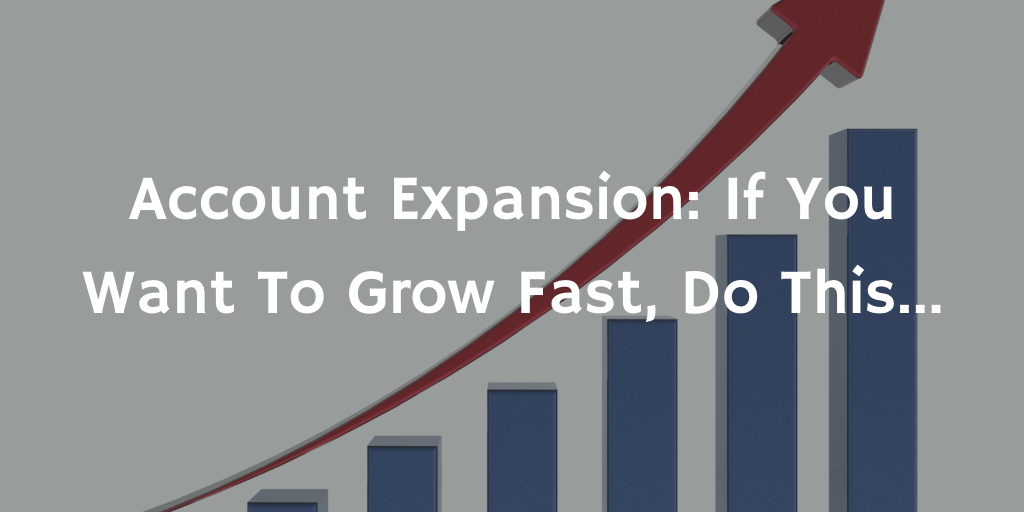 If you want to grow fast, don’t do what most companies do!
If you want to grow fast, don’t do what most companies do!
When most companies want to eke out some quick incremental growth, they’ll often have their sales people turn to their existing customer base to make some sales.
After all, you have a captive audience that you can sell to with little to no real effort, right?
Yeah… and you’ll get little to no real results, too.
Look, your existing customer base IS incredibly valuable… assuming you leverage that asset the right way.
Most companies handle Account Expansion poorly and therefore experience very poor results.
If you don’t want to be like most companies and to actually grow fast, leaving incremental growth for the other guys, and doing so in a customer-centric (and therefore sustainable!) way, continue reading.
This post could change your business. Seriously.
Okay, so you want to grow fast? Do this…
Have one team dedicated to bringing in net new Good-fit customers and a different, separate team dedicated to growing the relationship with those successful customers.
Now you have a two-pronged growth engine!
This customer growth team could be your CSMs (Customer Success Managers), CSMs + AMs (Account Managers) for more complex situations, or for really complex situations it could be CSMs + ADRs (Account Dev Reps) + AMs.
If you don’t have sales or success teams and everything is self-service, cool… just think of new customer acquisition as something different from customer growth and operationalize, design, and develop each in their own appropriate way.
If you have your “new business” salespeople also handle upsells in addition to bringing in new logos you can watch your business grow… slower than you’d like.
If you only have one team doing both new business and expansion sales, at best it divides their focus, resulting in slower growth.
But if that ONLY cut the time dedicated to both of those functions in half, while it would slow growth considerably (kinda the opposite of what we’re trying to do here), no further damage would be done and it wouldn’t be so bad.
That’s just not reality, though.
You see, one of the main reasons having “new business” salespeople handle expansion is bad is that it breeds laziness and teaches customers to ignore you.
Instead of having to go out and prospect (that’s hard, you know), the salesperson can just turn to existing customers to hit their numbers, which is much easier.
But the real problem, of course, is that your AEs treat them as if they’re prospects, not existing customers we already have an ongoing and oftentimes complex relationship with.
I’m sure some amazing, rockstar AEs that do both new logo and expansion sales can code switch from cold prospects to existing customers and do no harm, but the reality is most people can’t. Or won’t.
So you’ll end up with an existing customer being hit with overly-aggressive sales tactics, for offers that don’t resonate, all while not considering whether the customer is successful or not.
And in far too many cases, the original AE isn’t the one that totally “owns” the customer, so other teams will probably be trying to sell them stuff, too.
Now they’re over-communicated with in a negative way and just start to ignore all comms from you – not just sales and marketing, but those intended to help them move toward their goal – while cultivating hatred for your company in the process.
Is this all the fault of the Salesperson? No. I mean, yes, they should know better as professionals (or even just grown adult humans), but most of the time it’s a leadership issue.
Someone put a process in place that almost ensured your valuable customers would be treated in a very negative way in an effort to get more money from them.
So yeah, leadership is to blame. Pow!
If you want to grow FAST, focus one team on going after good-fit, net new customers, and have another team dedicated to growing the relationship with those successful customers.
Pow! Pow!
I always say, “If you want to stay a small company, have the original AE also handle Upsells” and it’s almost always met with frustration and push back. From sales.
Why? For starters, it’s “easier” for the AE to tap into existing customers to hit their numbers like I said above. But it’s more than that.
The way AEs are measured, managed, and compensated would be negatively impacted (and might actually be short-term; take this into consideration because it’s real) by the changes I’m talking about here.
That doesn’t make what I’m saying less valid, it just means the knee-jerk reaction is to push back on it. Some leaders frankly don’t want to deal with that pushback even though they know it’s not what’s best for the business as a whole.
Those aren’t actually leaders, by the way.
So in order to make these changes – which often means changing org structures and process that are years- or decades-old – this takes leadership buy-in and a dedication to making it work. Sometimes you have to get messier to get out of a messy situation.
But the exponential growth possible from doing Expansion the right way vs. the incremental growth that comes with the status quo should be enough.



